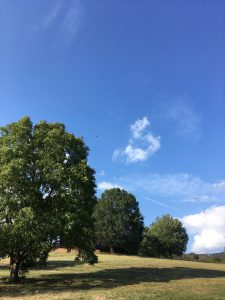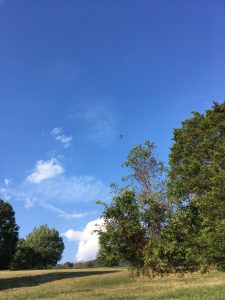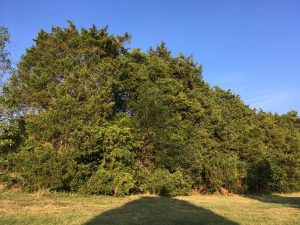My sit spot is located 50-100 yards behind the tennis courts, 200 yards or more north of Tinker. The location of my sit spot is also 15-20 feet from the two trees to the north, and around 20 feet from the grouping of evergreen trees to the east. The sit spot happens to be in a particularly sunny spot, so I moved my mat about 5 feet from my usual spot to find refuge in some shade. The location is filled with wildlife activity and often I enjoy watching the birds and squirrels. During my quiet observation I noticed the smell of my sit spot had changed since my last visit, it now smells more like fall. Fall to me smells like falling leaves that are dead and dying crunchy grass. There was also a noticeably less amount of insect activity this time than last, there were no cycads to be heard but plenty of crickets. I could also hear the blue jays more than the last visit as well as see more that fifteen of them. Today there were a few more planes to disrupt my quiet time but that is to be expected, and the birds don’t seem to mind.

Turkey vulture
Of the three objects that I have chosen to follow I was sure to observe them with close detail today, the small tree to the north along with a slightly bigger tree as well as the grouping of evergreens to the east. The larger tree to the north had a slight yellow coloration to the leaves compared to last visit, however not much change could be noted. The evergreens I have chosen to follow have not changed at all, as to be expected. However, the small tree to the north of my location has lost almost three fourths of the leaves on its branches which is a considerable amount compared to the third gone last week.

Red-Tailed Hawk
As I walked around my sit spot, a small tree on the edge of the evergreen grouping caught my eye. Upon further examination I noticed that the tree seemed to be entangled with a strong vine, but also fruit that looked to be grapes. However, my instinct that the plethora of birds around my area have not eaten the so-called grapes led me to assume they are probably not safe for consumption, as they seemed to be untouched. I then walked to my large tree to the north and noticed that the thick bark on the tree seemed to be peeling closer to the top, I found this very interesting. Then on to the small tree just below the big tree, I noticed small woodpecker holes in the trunk of the tiny tree. These are all things I would have never noticed if I had not gotten up to look at them closely.
Walking around for close examination of my sit spot was very interesting, I learned many things about my location that I would have never known. I learned many new and interesting characteristics about the plant life I have chosen to follow. It was also interesting to see that my sit spot has been visited by such a creature as a woodpecker which would be amazing to see. I would have walked around at some point to better familiarize myself with my sit spot and all it has to offer, so this was the perfect opportunity. I am intrigued to find out more about what kind of species my trees are and perhaps what those tiny berries I found are.
Most trees at my sit spot are starting to change colors in preparation for on coming winter however the large tree to the north of my sit spot is not yet really started changing. With the dry summer, it leads me to suspect that the tree possesses an adaptation to the water being scarce, maybe through an alternate form of photosynthesis. Or perhaps it has smaller leaves that leave less stomata available to emit water in such a hot and dry summer, or maybe a deeper root system to obtain water further down in the ground. I watched as several turkey vultures and a gorgeous red hawk flew overhead, they have an adaptation to food scarcity in the winter through which the migrate south where food is abundant. It was fun to be able to see these birds and be able to identify them as they flew past and know about their adaptations to the on coming winter and the lack of food it will bring. I also noticed that the blue jays seem to be nesting in the evergreens which could be from a behavioral adaptation to understanding that they provide year-round protection with their foliage from predators, which is an amazing survival adaptation. It was easy to think about the adaptations my surrounds might possess since we have be recently talking about them in class.

small tree to the north

large tree to the north

evergreen trees to the east

Leave A Comment
You must be logged in to post a comment.